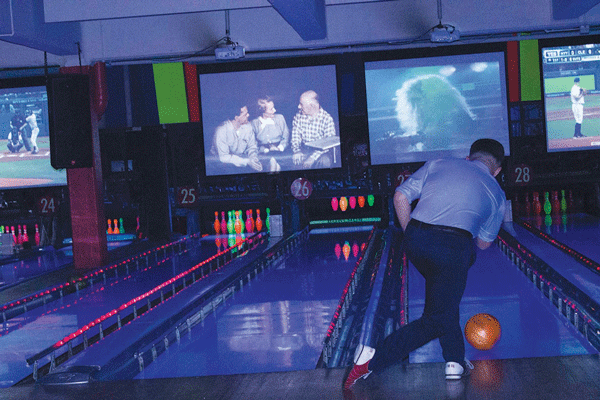
BY ZACH WILLIAMS | Even on the evening of Mon., July 7, the final day of a 76-year run, much remained the same at Bowlmor Lanes.
The elevator attendant ran the antique cab up to the second floor of 100 University Place, as he had for decades. Dance music played loudly. The lights were dim and couples romanced between turns. Monday night business appeared slow but steady as the dozen lanes on the second floor gradually became filled with patrons. The walls were festooned with celebrity autographs and old news clippings, as well as oversize flat-screen TVs.
But despite the typical buzz of activity and the clatter of bowling balls slamming into pins, the longest continually operated bowling alley in New York City closed at 1 a.m. the next morning to make way for new condominiums.
“It’s a painful loss,” said Bowlmor owner Tom Shannon.
Bowlmor operated at the location since 1938. And it was here, under Shannon, that recreational bowling as we know it today was transformed.
Among the famous who laced up bowling shoes there were Richard Nixon, Jimmy Fallon, Uma Thurman, Julia Roberts and Paul Shaffer.
Business flourished during the 1940s until the 1960s, when a decline hit both the sport and the city. A chance birthday party held there in the mid-1990s inspired Shannon to re-imagine the space, he said.
This was where bowling alleys became a bit pricier and more akin to a disco club than the previous business model, where bowling leagues dominated, according to Shannon.
“I made bowling expensive,” he quipped.
Bowling alleys now emphasize fun and entertainment rather than exclusively athletic competition. He realized such a vision in 1997 when he bought the venue through a $3,000 downpayment on a $2 million loan with 17 percent interest. What had been a dilapidated bowling alley losing money became the model of what is now the largest bowling empire in the United States with more than 265 locations.
Critics at the time said the low ceilings, “rickety elevator” and ongoing decline of bowling leagues would make it difficult to turn a profit on University Place, Shannon said.
“When I bought it, we were doing a million dollars a year,” he said. “Within four years, we were doing 10 million, so they weren’t exactly right.”
However, the building hosting the recreational hub for the glitterati and neighborhood residents alike is owned by real estate developer Billy Macklowe, a man with business ambitions of his own, who decided not to renew Bowlmor’s lease on the space.
According to Shannon and local media, the site will be redeveloped as residential condominiums. An offer of $20 million for two floors of the building did not pique Macklowe’s interest, Shannon said.
A Macklowe spokesperson declined to comment on the future of 110 University Place.
The last night of business, though, featured little evidence of the impending closure. The raucous mix of black lighting, Justin Bieber tunes, drinks and bowling attracted new patrons, even as employees huddled to exchange final reflections on what 110 University Place had meant to both their company and their friendships.
Brooklyn residents Olga Skyba and Samuel Weisman were there for the romance as well as sport. They said they were unaware that Bowlmor would be closing its original location on the very first day that they came there. The ambiance defines the venue, Weisman said.
“I like it better here, the music, atmosphere and everything,” he said. “I’ve been to other bowling alleys in Brooklyn, but this seems to be nicer actually.”

















